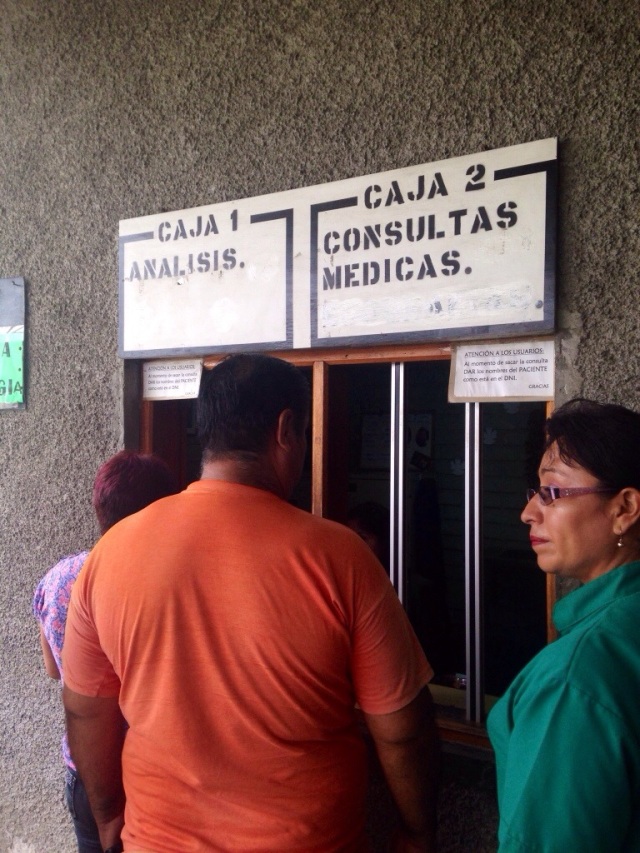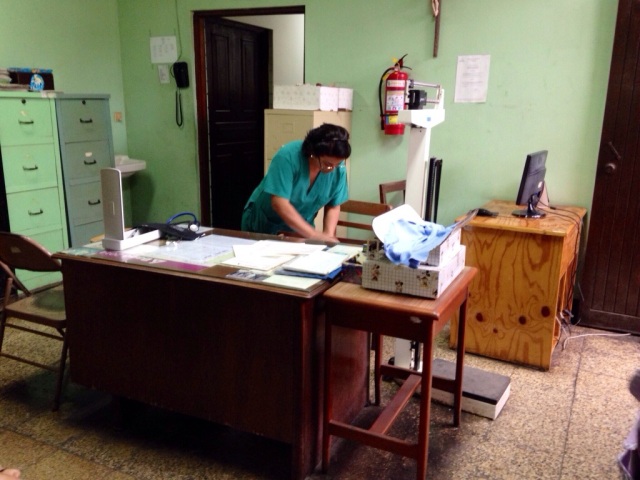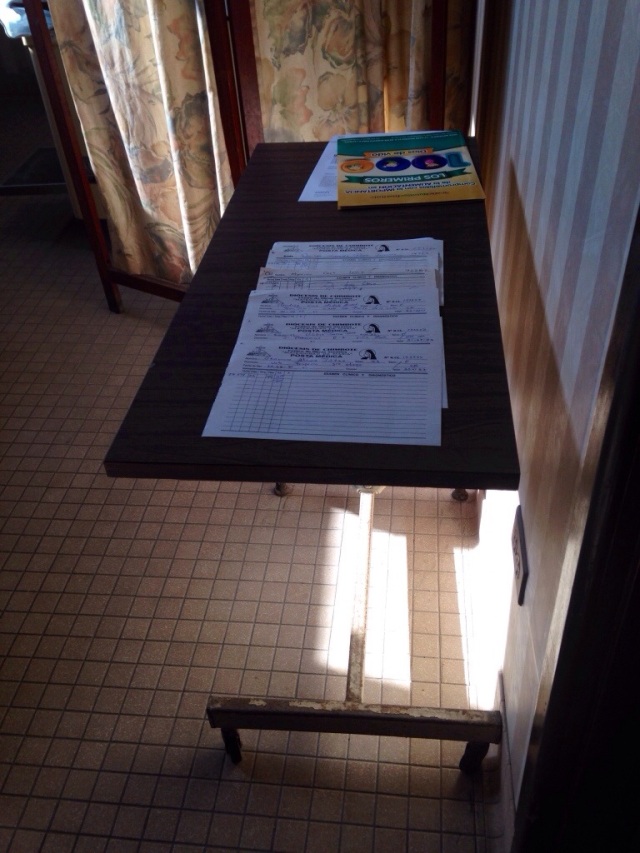As mentioned in a previous post, I go on home visits in the mornings. I return to La Maternidad de Maria in the afternoon at approximately 2:30 after my lunch break. For the past two weeks, I have worked in the Posta Medica (the Outpatient Clinic) in the afternoons. The Posta Medica serves many, many people every day so it is necessary for them to have a functioning, organized system in order to have everyone seen. Patients start by checking in for either an analysis or medical consultation.

From what I have observed, they receive a slip of paper confirming they have checked in, along with a number. They then wait in the waiting area for their number to be called. Once it is called, they are weighed, their height is measured, and their blood pressure is taken in the below pictured area and recorded on a form. 
These forms are then brought to the different doctors’ offices–this is where I come in! My main job in the Posta Medica is to call in the patients of the doctor that I am working with and observing that day.

Now, as I am sure you can imagine, the names here in Peru are very different than the names in the United States. Even if the names are the same, the pronunciations are always, always different. To save myself as much embarrassment as I can and to make sure I call in the right person, I always ask the doctor how to pronounce the names before I yell them down a hallway for the entire Posta Medica to hear. While I have started to recognize common names and remember their pronunciations, I still constantly struggle with any last names that have double r’s in them. I CANNOT, no matter how hard I try, pronounce the double r’s–this brings much amusement to the nurses and doctors (but hey they cannot pronounce the double t’s in my last name so this should be a judgment free zone!). On top of this, the people not only have one last name, but have two (the father’s last name and the mother’s maiden name) so I have to pronounce three names when calling people in to their appointment (because two names wasn’t hard enough!).
From this point on, I observe the doctor’s appointment and do my best to understand why the patient is at the clinic. I try and diagnose the patient before the doctor does, but this is not always possible when some of the cases are more complex than sore throat, cough, fever, or pain in a certain part of the body. Although a lot of the small talk and detailed medical talk goes over my head, I typically understand the general reason why someone is there. It is quite helpful that many names for diseases and illnesses in Spanish are very similar to the English names. The most beneficial experience for me was when I observed a doctor who also speaks English so after the patient had been seen I could re-cap with her in English what I thought had transpired and see if I was right. She could also explain to me details I had missed. My observations are very advantageous to my learning and understanding of healthcare in Peru because it gives me a view of the typical ailments in the country. When I observed a pediatrician, I saw a lot of flu, colds, and asthma in the kids. When working with three other doctors, I observed many cases of diabetes, cold symptoms (sore throat, cough, fever, etc.), and pain in the back/arms/legs. Beyond this I saw a couple cases of cysts in women, a woman with a urinary tract infection, people with anemia, children with rashes, a man concerned about osteoporosis, a child with bronchial pneumonia, a young girl with tuberculosis, a man with an enlarged prostate, and a handful of other illnesses and health problems. Although I do not study medicine (and so cannot practice it on patients), the doctors sometimes let me help examine a patient. I have listened with a stethoscope to the lungs of a child with asthma and to the lungs of the child with bronchial pneumonia, looked in the ears of a boy with a cold, and observed x-rays of peoples’ lungs, knees, and heels.
Beyond observing the doctor’s visits, I have also used my time working in the Posta Medica to learn how everything is conducted. One of my main observations is that besides one computer in the room where peoples’ height, weight, and blood pressure is taken, there are not any computers in the doctors’ offices. This is shockingly different than in the United States where there is at least three computers at the check in and a computer in every doctor’s office. A shift to Electronic Health/Medical Records is a big thing in the healthcare world in the U.S. right now. Having a computer allows all of the information to be stored in one place and easily accessible by the doctors. However, due to the cost of computers (I assume), having a computer in every doctors’ office is not realistic here in Peru at La Maternidad. The clinic uses slips of paper (as shown above) that are customized for La Maternidad and once one slip gets filled with a patient’s visits a new slip is stapled to it. Once there are enough slips to warrant a small folder, one is used to hold all of the patient’s slips together. This system appears to work quite well and efficiently for the Posta Medica although there are a few slips forgotten here and there since it is easy to misplace a piece of paper and information that is not stored and saved in a computer. La Maternidad makes great use of the resources they have and is a great model for clinics in developing countries that have limited access to technological resources!
Pictures of la Posta Medica:









Jules ~ love reading your posts! Beautiful pictures! I am so proud of you!!! Love, Dawn